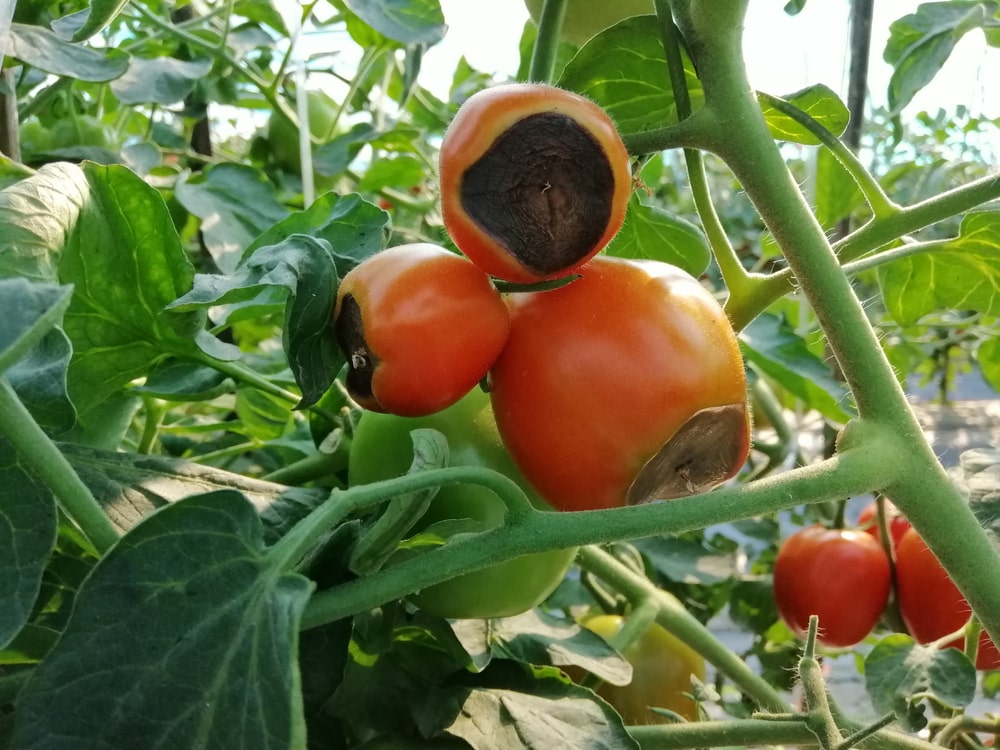Unfortunately, our commonly grown garden vegetables are prone to specific problems. Tomatoes can get Early Blight, Late Blight, Southern Blight, Gray Leaf Spot, Septoria Leaf Spot, Verticillium Wilt, Anthracnose, Fusarium Wilt, etc., as well as aphids, stink bugs, and tomato hornworms.
Cucumber family members (cukes, squash, melons, pumpkins) can get Wilt, Powdery Mildew, Downy Mildew, Alternaria Leaf Spot, Mosaic, etc., and are particularly prone to squash vine borers and squash bugs.
Ways to Help to Prevent Problems
Here are things you can do to help prevent problems in your garden.
Keep your garden free of weeds and debris.
Plants don’t like to compete for nutrients. But even more critically, weeds and debris give insects a place to lay eggs and/or hide. And they provide a breeding ground for diseases.
Allow adequate air circulation around your plants.
You want to cram into your space as much as possible when your space is limited. But with high summer humidity, we are just asking for trouble. Planting too close together limits air circulation around the foliage and allows insects and diseases to transmit easily.
Don’t wet the foliage when watering your garden.
We already have high humidity during summer, so why compound the problem by getting water all over the foliage when we water? I like soaker hoses because they put the water right where you need it—on the roots—and not where I don’t need it. If you don’t use a soaker hose, water with a hose—at the base of the plant where they need it—not all over the leaves.
Be observant.
Get in the habit of checking your garden every couple of days. Catch insect or disease problems early. They’re much easier to deal with than when they’ve gone unchecked and are EVERYWHERE. Check the back of the foliage for insects or eggs and treat immediately. Eggs can be easily removed by using the sticky side of tape. Pat them. Voila! Gone. Insects can be dealt with using Neem oil or any good organic pesticide. Remember to spray just before dark to avoid killing bees.
What to Look For
Check for foliage that doesn’t look right. Here is a brief description of some of the more common garden diseases—mostly tomato family. For a better diagnosis, check online for a picture of your problem.
Blight (Early or Late)
Circular or irregularly shaped dark spots surrounded by yellow on older leaves first. Stressed plants are most at risk, so do not allow plants to wilt. Water thoroughly without over-watering. Don’t fertilize until the first flowers appear. Use a lower nitrogen fertilizer (like Tomato-tone). Blight can be easily transmitted when foliage is wet, so avoid handling plants right after rain. Pick off the affected foliage and treat the plant with a mild organic fungicide.
Fusarium Wilt
Yellowing and wilting of leaves tend to occur on one side of the plant. In the early stages, top growth may wilt in the sun and recover in the evening, even if the soil is moist. Planting in a well-draining spot is essential. Remove and destroy infected plants, as there is no effective home treatment. DO NOT put another tomato (or family members like peppers or eggplants) there for three years, as the disease can linger in the soil.
Verticillium
Yellowing and wilting of leaves will occur all over—starting at the bottom. Top growth may wilt in the sun and recover in the evening. Plant tomatoes in well-draining soil only. Remove and destroy infected plants and keep tomato family members out of there for three years.
Septoria leaf spot
Small spots with darker brown margins appear. Heavily infected leaves will turn brown and fall off. Wet foliage and prolonged spells of wet cooler weather can affect. Do not use overhead watering. Remove and destroy infected plants.
Tobacco Mosaic
Yellowish green and dark green patches. New leaves may be ferny and distorted in appearance. Infection of garden plants can be caused by smoking near tomato family members. Do not smoke or handle tobacco products near tomatoes or related plants. Mosaic can also show up in cucumber family members.
Powdery Mildew
A grayish-white film appears on foliage. Cucumbers and squash are very prone to it. Our high humidity is the culprit. Avoid getting water on the plant foliage. When it first shows up, remove the worst of the affected foliage and apply an organic sulfur-based fungicide—spray very early in the morning or just before dark to avoid sunburn (and to protect pollinators). Keep weeds and debris out of the garden to avoid spores wintering over.
Blossom End Rot
Have you ever picked that beautiful ripe tomato only to find the bottom is black? That’s a disease called Blossom End Rot. Tomato family members are prone to it. A calcium deficiency usually causes it. This is why I use Tomato-tone—it has added calcium. Eggshells crushed and added to the soil will help—in several years once they have composted down.
More Questions?
Here at the Great Big Greenhouse and Nursery, we love plants and are here to answer your questions and make recommendations for your specific garden. Stop by today and let us help you make your garden the envy of the neighborhood.

